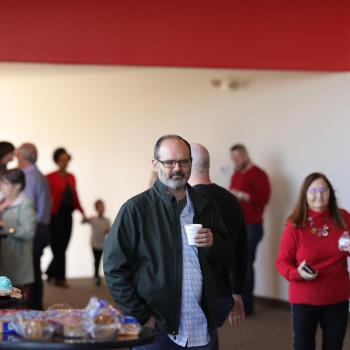Communion, pt. 4 | Early Influences, Didache, Clement of Rome, and Ignatius

Didache
The Didache is considered by some to be a very early church document, and a later one by others (first or second century respectively). However it offers guidelines that appear to be formative for the early church. Robert Webber looks at the form prayer suggested by the Didache and states that it is essentially a call for unity in the church, to gather the church.[1]
The Didache’s prayers for the agape or the Eucharist can be offered extemporaneously. Dom Gregory Dix summarizes:
“Prophets, as specially inspired persons, even though laymen, are not bound to use the set forms; just as the bishop, in virtue of his prophetic charisma, is not bound to follow a set form in the eucharistic prayer proper.”[2]
Dix points to the Spirit with the term charisma. The primitive church seems to recognize the giftings of the Spirit at the Lord’s Table.
Clement of Rome
Clement (circa 30-100) writes to establish church authority. He is the pastor at Rome. His letter to the Corinthians is the earliest Christian document outside the New Testament.[3] Clement seems to have apostolic authority. Roger Olson states:
“Some scholars believe, based on internal evidence in this letter, that Clement must have known Paul personally and imitated his style and message.”[4]
Pope Benedict XVI reports that Irenaeus testifies that Clement:
“‘had seen the blessed Apostles,’ ‘had been conversant with them,’ and ‘might be said to have the preaching of the apostles still echoing [in his ears], and their traditions before his eyes.’”[5]
What does Clement hand down from the Apostles? On the Eucharist, “Clement had written from Rome that the ‘bishop’s office’ is to ‘offer the gifts’ (prospherein ta dora).”[6] Dix explains the differences in the functions of bishops and presbyters, which is the general theme of the epistle, but an underlying truth surfaces – the Eucharistic gifts are offered in sacrifice.
Ignatius
Ignatius eventually becomes a martyr, but before he does, he writes several letters to the churches. He identifies himself as the bishop of Syria.[7] “St. Ignatius was the third bishop of Antioch from 70 to 107.”[8] He is the earliest voice of the East. Dix says that for Ignatius:
“the eucharistic assembly of the church is thusiasterion ‘the place of sacrifice’, and ‘he who is not within it is deprived of the bread.’”[9]
Ignatius views the Eucharist as a sacrifice offering to God, like other early liturgies.
He also sees a divine mystery in the sacrament. Ignatius states:
“the Eucharist is the flesh of our saviour Jesus Christ . . . the medicine of immortality, the antidote against death which gives eternal life in Jesus Christ.”[10]
Roger Olson states that Ignatius truly contributes to our understanding of the prayer and communion as means of grace, with power to transform believers.[11]
For more on Communion in the Early Church from the Archives CLICK
notes:
- Robert E. Webber, Ancient-Future Faith: Rethinking Evangelicalism for a Postmodern World (Grand Rapids, MI: Baker Books, 2004), 85.
- Dom Gregory Dix, The Shape of the Liturgy, 3rd ed. (London: Bloomsbury T&T Clark, 2015), 93.
- Earle E. Cairns, Christianity Through the Centuries, 2nd ed. (Grand Rapids, MI: Academie Books, 1981), 73.
- Roger E. Olson, The Story of Christian Theology: Twenty Centuries of Tradition and Reform (Downers Grove, Il: IVP Academic, 1999), 43.
- Pope Benedict XVI, The Fathers of the Church: From Clement of Rome to Augustine of Hippo (Grand Rapids, MI: Wm. B. Eerdmans, 2009), 1.
- Dix, 111.
- Dale T. Irvin and Scott W. Sunquist, History of the World Christian Movement, Volume I: Earliest Christianity to 1453 (Maryknoll, NY: Orbis Books, 2009), 61.
- Pope Benedict XVI, 5.
- Dix, 113.
- Henry Bettenson and Chris Maunder, eds., Documents of the Christian Church, 4th ed. (New York: Oxford University Press, 2011), 79.
- Olson, 48.












